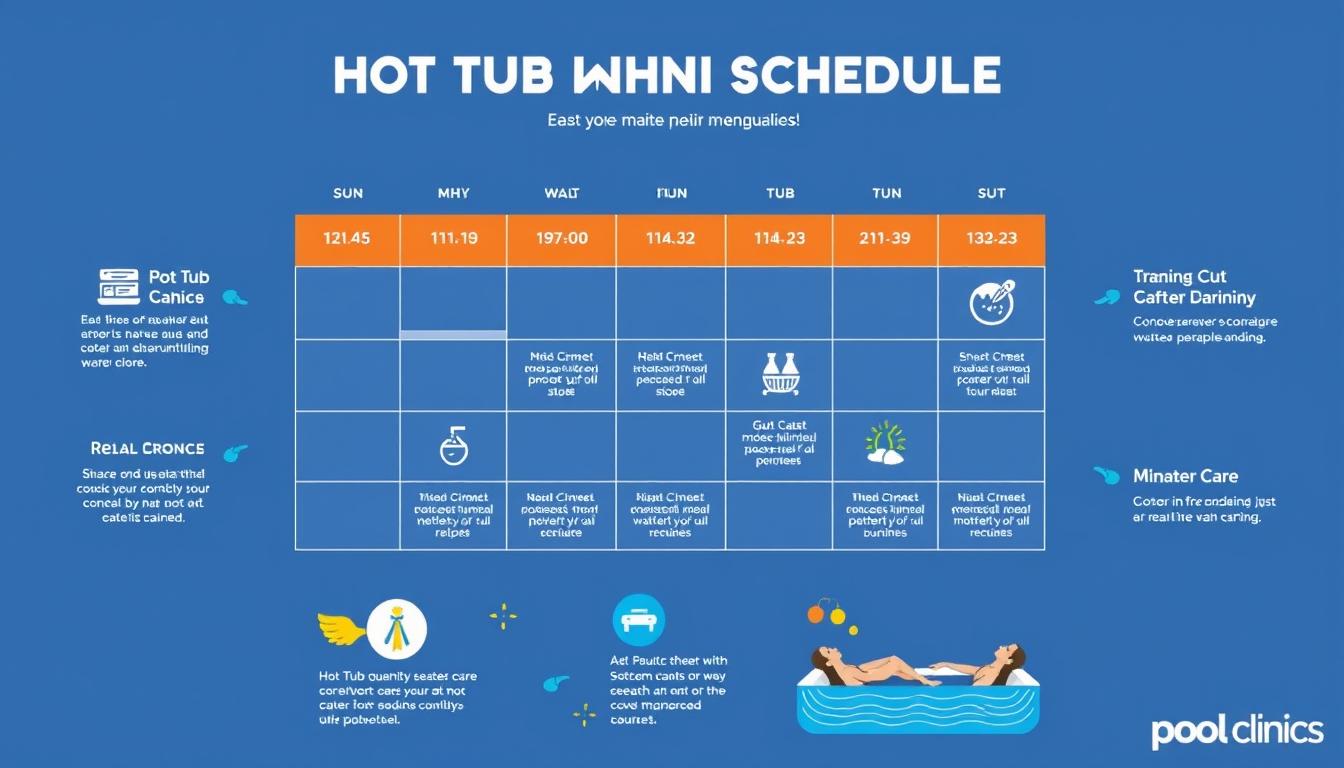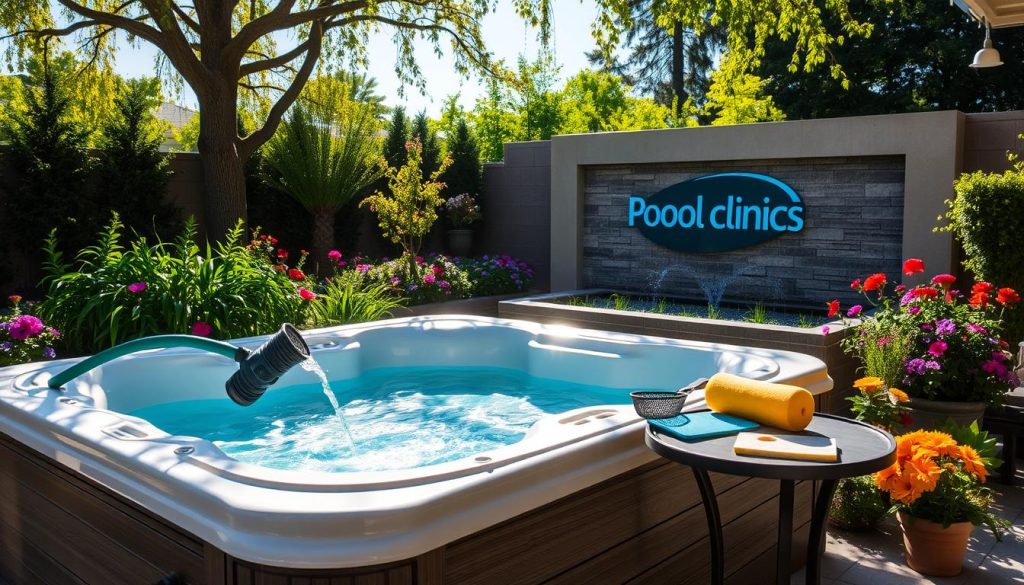
Hot tub owners love relaxing in their backyard oasis. The warm, bubbling water soothes tired muscles and melts away stress. Proper maintenance is crucial to keep your hot tub clean and inviting.
Experts suggest draining and refilling your hot tub twice a year. This practice maintains optimal water quality and prevents costly repairs. Over time, water absorbs minerals, organic matter, and other contaminants.
Filters can’t remove all these impurities. The buildup of total dissolved solids (TDS) can cause problems. These include cloudy water, excessive foaming, and difficulty balancing chemicals.
Regular water replacement helps avoid potential health risks. It also keeps your hot tub running smoothly. Draining allows for a thorough deep clean of the shell.
Running a special cleaner through the plumbing removes accumulated residue. This ensures your spa stays in top condition. Following these guidelines will help you enjoy a clean, safe hot tub year-round.
Key Takeaways
- Drain and refill your hot tub twice a year for optimal water quality
- High TDS levels can cause cloudy water, excessive foaming, and chemical imbalances
- Regular water replacement prevents costly repairs and health risks
- Draining allows for thorough cleaning of the shell and plumbing
- Establish a consistent hot tub maintenance schedule for year-round enjoyment
Why Regular Draining & Refilling Is Essential
Maintaining a consistent hot tub cleaning routine is crucial for spa longevity and performance. Regular draining and refilling help maintain optimal water chemistry. This task prevents issues that can arise from neglect.

Total Dissolved Solids (TDS) Buildup
Draining and refilling your hot tub manages Total Dissolved Solids (TDS) levels. Minerals, chemicals, and particles accumulate in the water, leading to high TDS levels. This buildup can cause hazy water, foaming, and reduced sanitizer effectiveness.
Draining your spa every three to four months maintains optimal TDS levels. This practice ensures your hot tub water chemistry remains balanced.
Residue Accumulation in Shell and Plumbing
Residue from minerals, body oils, and contaminants can build up on the shell and plumbing. This buildup can harbor bacteria and affect water clarity. Regular draining allows thorough cleaning of the shell and plumbing.
Maintaining Optimal Chemical Balance
Proper chemical balance is essential for bather comfort and system efficiency. Ideal ranges for key parameters include:
- pH levels between 7.4 and 7.6
- Alkalinity between 80 and 120 parts per million (ppm)
- Sanitizer levels of 3-5 ppm for chlorine or bromine
Draining and refilling with fresh water helps adjust and maintain these critical levels. This practice ensures your hot tub sanitation remains effective.
Preventing Damage to Hot Tub Components
Neglecting to drain and refill regularly can damage various spa components. Accumulated minerals and residue can cause scale buildup on pumps and jets. This reduces efficiency and potentially leads to costly repairs.
A consistent draining schedule protects your investment and extends your hot tub’s life.
| Component | Potential Damage | Prevention |
|---|---|---|
| Pumps | Scale buildup, reduced efficiency | Regular draining and cleaning |
| Jets | Clogged or reduced flow | Flushing plumbing during draining |
| Heater | Scale accumulation, reduced heating efficiency | Maintaining balanced water chemistry |
Regular draining and refilling is crucial for a healthy and enjoyable spa experience. This practice ensures optimal water quality and prevents component damage. Your hot tub will provide years of enjoyment with proper maintenance.
Signs Indicating It’s Time to Drain Your Hot Tub
Recognizing when to drain and refill your hot tub is crucial. Monitor water quality and watch for unusual changes. This helps maintain a safe, clean, and enjoyable soaking experience.
Here are key indicators that suggest it’s time for a complete water change:
Foul Odors Emanating from the Water
Strong, unpleasant odors from your hot tub signal high contaminant levels. These can range from chemical to musty smells. If cleaning and shock treatments fail, it’s time to drain and refill.
Cloudy or Discolored Water
Crystal clear water shows a well-maintained hot tub. Cloudy, murky, or oddly colored water indicates quality issues. This can result from algae, high dissolved solids, or chemical imbalance.
If cloudiness persists despite your efforts, drain and refill your spa.
Excessive Foam Buildup
A little foam is normal, but excessive foaming is a red flag. It often shows buildup of oils, lotions, and hair products. If anti-foam products don’t work, drain and refill your hot tub.
Difficulty Maintaining Consistent Chemical Levels
Constant chemical adjustments may mean oversaturated water. When sanitizers and other products stop working, it’s time to drain. Address this issue quickly to avoid water quality problems.
| Type of Mold | Appearance | Potential Health Risks |
|---|---|---|
| Dark Gray or Black Spots | Tiny, dark specks on hot tub surfaces | Respiratory issues, allergic reactions |
| White or Greenish Patches | Fuzzy or slimy patches on hot tub shell or cover | Skin irritation, rashes, infections |
Stay alert to these warning signs for a clean, safe hot tub. Regular draining, refilling, and proper maintenance ensure a relaxing spa experience.
Combine these practices with thorough filter cleaning to keep your hot tub inviting and contaminant-free.
How Often Should You Drain Your Hot Tub
Draining and refilling your hot tub regularly keeps it clean and safe. Most experts suggest doing this every 3-4 months. However, your specific needs may vary based on several factors.
Adjusting your maintenance schedule ensures a great soaking experience. Let’s explore what affects how often you should drain your hot tub.
Factors Influencing Draining Frequency
Several factors can affect how often you need to drain your hot tub. These include usage patterns, number of bathers, and filtration system efficiency.
Water chemistry and environmental factors also play a role. Proper maintenance can help extend the time between water changes.
- Hot tub usage patterns: Heavy usage or frequent guests may necessitate more frequent water changes.
- Bather load: The number of people using the hot tub can impact the accumulation of contaminants and the need for draining.
- Filtration system efficiency: A well-maintained and efficient filtration system can help extend the time between water changes.
- Water chemistry: Consistently maintaining proper water balance can prolong the life of your hot tub water.
- Environmental factors: Seasonal variations and external contaminants can influence the frequency of cleaning and maintenance.
General Recommendation: Every 3-4 Months
Draining and refilling your hot tub every 3-4 months is a good rule of thumb. This schedule helps reduce buildup of dissolved solids and maintains chemical balance.
Regular draining also prevents biofilm accumulation and protects your hot tub components. It ensures optimal performance and longevity of your spa.
- Reduce the buildup of total dissolved solids (TDS) such as minerals, body oils, and lotions.
- Maintain optimal chemical balance, leading to more efficient use of sanitizers and balancing agents.
- Prevent the accumulation of biofilm and other contaminants in the shell and plumbing.
- Ensure the overall health and longevity of your hot tub components.
Adjusting Frequency Based on Usage and Observations
The 3-4 month guideline is a good starting point. However, it’s important to monitor your hot tub’s condition regularly.
Adjust your draining schedule based on usage patterns and water quality. Pay attention to signs like cloudy water or foul odors.
| Usage Pattern | Recommended Draining Frequency |
|---|---|
| Heavy Usage or Frequent Guests | Every 1-2 Months |
| Average Usage | Every 3-4 Months |
| Low or Seasonal Usage | Up to 6 Months |
Test your water’s TDS levels regularly. This helps determine when it’s time to drain and refill. Watch for difficulty maintaining consistent chemical levels.
By understanding these factors, you can create a perfect maintenance schedule. This ensures your hot tub remains a clean, safe oasis for relaxation.
Conclusion
Draining and refilling your hot tub keeps it clean and safe. Experts suggest doing this every 3 to 4 months. However, this may change based on how often you use it.
Clean the shell, plumbing, and filters during draining. This removes biofilm and other contaminants. These can cause issues like foamy water, unbalanced pH, and bad smells.
Follow hot tub maintenance best practices to extend its life. Pay attention to signs that show you need to change the water. This will help you enjoy your hot tub for years.
Hot tub care tips include keeping the pH between 7.2 and 7.8. Clean filters regularly and test sanitizer levels. Adapt your maintenance to how you use your hot tub.
By following these steps, your hot tub will remain a source of relaxation. You and your loved ones can enjoy it for a long time.







